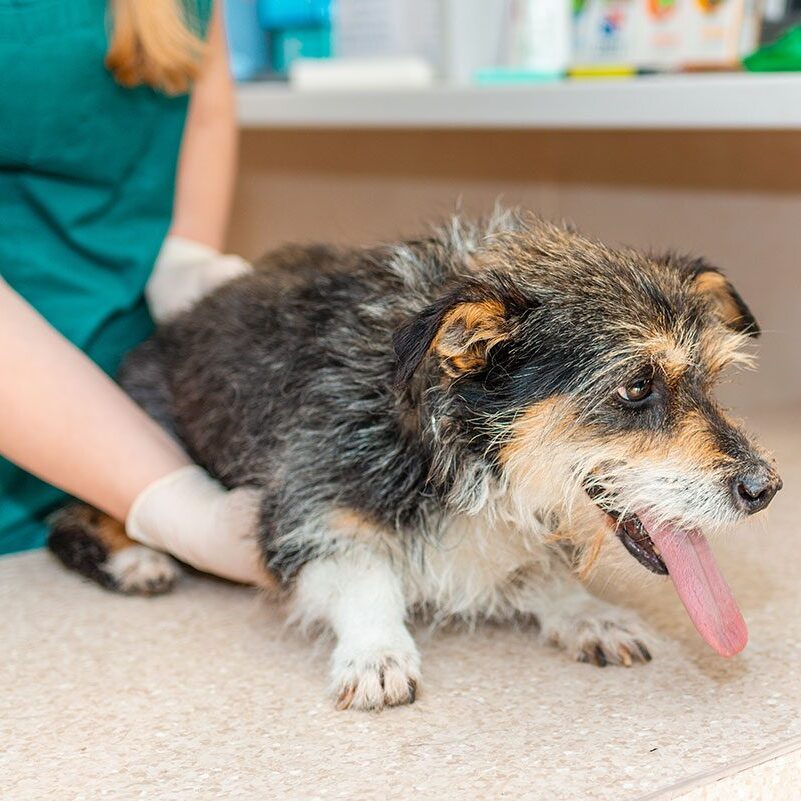
Canine hip dysplasia (CHD) is a common orthopedic condition that affects a dog’s hip joints, often leading to pain, discomfort, and mobility issues. While it is primarily a genetic condition, environmental factors also play a role in its development.
Understanding Canine Hip Dysplasia
In a healthy hip joint, the head of the femur (thigh bone)—the “ball”—fits securely into the acetabulum (hip socket) of the pelvis, allowing smooth, fluid movement. In dogs with hip dysplasia, the joint develops abnormally, creating looseness (laxity) between the ball and socket. This poor fit leads to rubbing and grinding instead of smooth gliding.
Over time, this abnormal movement can cause:
- Joint Instability: Stretching of the ligaments and muscles that support the hip.
- Cartilage Erosion: Wearing down of the protective cartilage, causing painful bone-on-bone contact.
- Bone Spurs: Formation of bony growths as the body attempts to stabilize the joint.
- Osteoarthritis (OA): Chronic, progressive joint degeneration that causes persistent pain and reduced mobility.
Causes and Risk Factors
- Genetics: Certain breeds, such as Labrador Retrievers, German Shepherds, Rottweilers, and Bulldogs, are more prone to CHD. Choosing a breeder who screens for hip dysplasia is important.
- Rapid Growth & Nutrition: Overfeeding and rapid growth in large-breed puppies increase risk. Feeding a large-breed puppy diet helps control growth rate and support healthy joint development.
- Obesity: Excess weight places added stress on the hips, worsening CHD and accelerating degeneration.
- Neutering Age: Some studies suggest early neutering (before about 5.5 months) may increase the risk in certain dogs.
Signs to Watch For
CHD can appear in puppies as young as a few months old or develop later in life. Common signs include:
- Limping or lameness in the hind legs, especially after activity or rest
- Difficulty rising, jumping, or climbing stairs
- A “bunny hopping” gait (moving both back legs together)
- Stiffness, particularly after rest or exercise
- Reduced activity or reluctance to play
- Pain when hips are touched or moved
- Decreased range of motion in the hip joints
- Muscle loss in the hind legs
- Narrow stance or a hip “sway” when walking
Diagnosis
- Physical Examination: Your veterinarian will palpate the hips and may perform the Ortolani test, which checks for joint laxity (often under sedation).
- Radiographs (X-rays): Provide a detailed view of hip structure and arthritis severity. Common methods include the Orthopedic Foundation for Animals (OFA) and PennHIP evaluations. PennHIP can detect hip laxity in puppies as young as 16 weeks.
Treatment Options
Treatment depends on the dog’s age, health, and the severity of the condition. Options range from conservative management to surgery.
Non-Surgical (Conservative) Management
Used in mild cases or when surgery is not an option:
- Weight Management: Keep your dog lean to reduce joint stress.
- Exercise Modification: Low-impact activities like walking and swimming build muscle without overloading the hips. Avoid high-impact exercise and jumping.
- Medications: NSAIDs and other pain relievers (e.g., gabapentin, tramadol, amantadine) can manage pain and inflammation.
- Joint Supplements: Glucosamine, chondroitin, omega-3 fatty acids, and injectable treatments like polysulfated glycosaminoglycans may help.
- Physical Rehabilitation: Hydrotherapy, laser therapy, massage, acupuncture, and targeted exercises improve mobility and comfort.
- Environmental Adjustments: Use orthopedic beds, ramps, and non-slip flooring to make movement easier.
Surgical Options
For severe cases or when conservative measures are ineffective:
- Juvenile Pubic Symphysiodesis (JPS): For puppies under ~20 weeks, it alters pelvic growth to improve hip coverage.
- Triple Pelvic Osteotomy (TPO): For dogs under 1 year before arthritis develops; repositions pelvic bones for a better fit.
- Total Hip Replacement (THR): Replaces the damaged joint with an artificial implant, restoring near-normal function.
- Femoral Head Ostectomy (FHO): Removes the femoral head to eliminate bone-on-bone contact; works best in smaller dogs.
Long-Term Outlook & Prevention
While CHD cannot be cured, most dogs can live active, comfortable lives with proper management. Regular veterinary check-ups help adjust treatment as needed.
Prevention Tips for At-Risk Breeds:
- Work with breeders who perform hip dysplasia screenings (preferably PennHIP).
- Feed an appropriate large-breed puppy diet to control growth.
- Maintain a healthy weight for life.
- Provide low-impact exercise and avoid overexertion in puppyhood.
- Consider delaying spay/neuter until skeletal maturity for certain breeds.
With early detection, proactive care, and appropriate treatment, dogs with hip dysplasia can enjoy many years of good quality of life.
Recent Posts
About Us
Knox Veterinary Surgery provides advanced orthopedic, soft tissue, and exotic pet surgeries right in your practice, making care easier for you and your clients. Serving Tennessee and surrounding states, we deliver skilled, compassionate care in a familiar setting.
